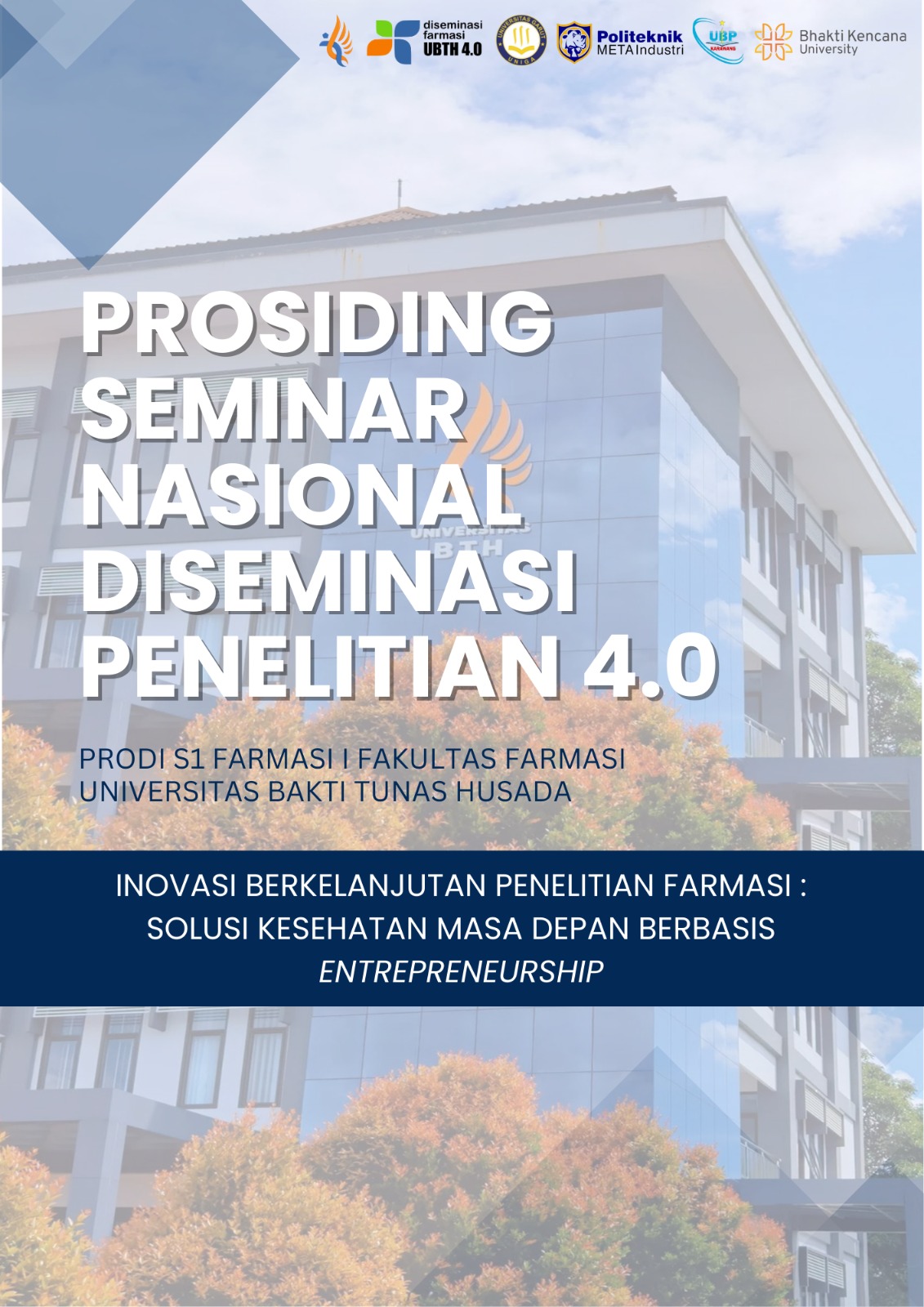Efek Kombinasi Rebusan Daun Kecombrang (Etlingera elatior (Jack) R.M.Sm.), Daun Kelor (Moringa oleifera Lam.), Daun Salam (Syzygium polyanthum (Wight) Walp.) dan Daun Sirsak (Annona muricata
Keywords:
diabetic, SGLT-2 inibitor, boiled leaves, Etlingera elatior, Moringa oleifera, Syzygium polyanthum,, Annona muricataAbstract
Background: Diabetes mellitus has emerged as a major issue in Indonesia and continues to increase
in prevalence. Hyperglycemia, or elevated blood glucose levels, serves as a primary marker of diabetes,
which is classified into type 1, type 2, gestational, and other types. Herbal remedies, including
kecombrang, moringa leaves, bay leaves, and soursop leaves, are utilized as natural alternatives to
help regulate blood glucose levels and enhance insulin sensitivity. Objective: To evaluate the effects
of a combination of boiled moringa leaves, kecombrang leaves, soursop leaves, and bay leaves on
diabetic mice. Method: Four types of leaves were combined and boiled at three different doses (13.2
mg/20 g body weight of mice, 36.4 mg/20 g body weight of mice, and 72.8 mg/20 g body weight of
mice), then administered orally to male mice for 7 days. Glucose levels were measured using a
photometer for urine glucose and a glucometer for OGTT, FPG, and urine glucose tests. The study
involved 24 male mice divided into six groups: a normal group, a positive control group, a negative
control group, and three treatment groups receiving dose 1, dose 2, and dose 3. The results were
analyzed using SPSS version 26 with the One-Way ANOVA test. Results: The results indicated that
the combination of the boiled leaves significantly reduced hyperglycemia, particularly at dose 2 (36.4
mg/20 g body weight of mice), which effectively lowered blood glucose levels and produced effects
comparable to those of the positive control. The dose 2 group also exhibited a significant reduction in
blood glucose levels compared to the negative control and demonstrated stable, consistent effects.
Conclusion: These findings suggest that the combination of boiled kecombrang, moringa, bay, and
soursop leaves at a dose of 36.4 mg is effective in reducing blood glucose levels in hyperglycemic mice.
However, the involvement of the SGLT-2 inhibitor mechanism was not observed.
References
BPOM. (2014). Peraturan Badan Pengawasan
Obat dan Makanan No 7 Tahun 2014
Tentang Pedoman Uji Toksisitas
Nonklinis Secara In Vivo. Badan
Pengawas Obat Dan Makanan Republik
Indonesia, 1–165.
Fadel, M. N., & Besan, E. J. (2021). Uji aktivitas
antidiabetes ekstrak daun sirsak (Annona
muricata L.) Pada mencit yang diinduksi
aloksan. Indonesia Jurnal Farmasi, 5(2),
1. https://doi.org/10.26751/ijf.v5i2.1170
Fitrianita, A., Yardi, Y., & Musir, A. (2018). Uji
Efek Antihiperglikemia Ekstrak Etanol
70% Daun Kecombrang (Etlingera Elatior)
pada Tikus Sprague Dawley dengan
Penginduksi Aloksan. Jurnal Ilmiah
Farmasi, 14(1), 9–16.
https://doi.org/10.20885/jif.vol14.iss1.art2
Gusti, I., Amandari, A. A. E., Sarasmita, A.,
Putu, N. I., Dewi, U. S., & Krisnayanti, W.
(2018). HANG TUAH MEDICAL
JOURNAL SGLT-2 Inhibitor: Pilihan
Terapi Baru Untuk Penderita DM Tipe 2.
Htmj, 16(1), 28–36.
Hariani, Sakung, J., & Nur, A. (2018). Pengaruh
pemberian infusa daun sirsak terhadap
penurunan kadar glukosa darah tikus.
Jurnal Kolaboratif Sains, 1(1), 176–185.
https://doi.org/10.56338/jks.v1i1.349
Hasim, H., Faridah, D. N., Safithri, M.,
Husnawati, H., Setiyono, A., & Manshur,
H. A. (2020). Aktivitas Penurunan Kadar
Glukosa pada Tikus yang Diinduksi
Aloksan dari Ekstrak Air Angkak, Bekatul,
dan Kombinasinya. Warta Industri Hasil
Pertanian, 37(2), 172.
https://doi.org/10.32765/wartaihp.v37i2.5
460
Kartikaningrum, V. (2022). Uji antihiperglikemia
rebusan daun salam (syzygium
polyanthum) pada mencit yang diinduksi
glukosa. Jurnal Pharmaqueous, 4(1), 92–
97. https://doi.org/10.36760/jp.v4i1.374
Kusuma, I. Y., Samodra, G., Komala, Y. I.,
Apriliansa, E. P., Piri, J. P. A., & Fauqina,
A. A. (2022). Glucose Lowering Agent
Effect Dapaglifozine Adds on Metformin
Therapy in Mice. Jurnal Ilmiah Farmako
Bahari, 13(1), 72–80.
Mira Febrina, & Sari, S. F. (2019). Pengaruh
Pemberian Infusa Daun Kersen
(Muntingia calabura L.) terhadap Kadar
Glukosa Darah Mencit Putih (Mus
musculus) yang Diberi Beban Glukosa.
Jurnal Penelitian Farmasi Indonesia, 8(2),
60–66.
https://doi.org/10.51887/jpfi.v8i2.783
Nofianti, T., Sulistiawati, S., & Gustaman, F.
(2022). Potensi Ekstrak Etanol Daun
Anggur (Vitis vinifera L.) dalam
Menurunkan Kadar Glukosa Darah yang
Diindukasi Aloksan. Prosiding Seminar
Nasional Diseminasi Hasil Penelitian
Program Studi S1 Farmasi, 2, 315–323.
Nurmalasari, Y., Rafie, R., Febrian, D., &
Rahma, S. A. (2021). Pengaruh
pemberian ekstrak daun kelor terhadap
kadar glukosa tikus putih yang diinduksi
aloksan sebagai upaya preventif
hiperglikemia. PREPOTIF : Jurnal
Kesehatan Masyarakat, 5(1), 472–483.
Oktavisa, A., Yuliana, R., & Fauziyah, E.
(2022). Serbuk daun kelor efektif
menurunkan kadar glukosa darah dan
kadar kolesterol pada individu obese.
Wiraja Medika : Jurnal Kesehatan, 12(1),
10–16.
https://doi.org/10.24929/fik.v12i1.1712
PubChem. (2024). Dapagliflozin. National
Center for Biotechnology Information.
https://pubchem.ncbi.nlm.nih.gov/compo
und/Dapagliflozin
Sinata, N., Pratiwi, I. D., & Muhtadi, W. K.
(2023). Uji aktivitas antidiabetes infusa
daun salam (syzygium polyanthum
(wight) walp.) Terhadap kadar glukosa
darah mencit putih (mus musculus l.)
Jantan yang diinduksi glukosa. Jurnal
Ilmu Kefarmasian, 4(1), 33–40.
https://doi.org/10.31764/lf.v4i1.9399
Syamra, A., Indrawati, A., & Auliyah Warsyidah,
A. (2018). Pemberian Rebusan Daun
Kelor Terhadap Penurunan Kadar
Glukosa Darah Pada Pasien Penderita
Diabetes Mellitus (DM). 8, 11.
Utami, W. D., Irwadi, D., & Farpina, E. (2024).
Perbandingan Glukosa Urin Dan Berat
Badan Urin Pada Penderita Diabetes
Melitus Tipe 2 Dengan Berbagai Waktu
Pemeriksaan Di Puskesmas Harapan
Baru. 11(1), 138–148.
Widyasti, J. H., & Kurniasari, F. (2019). Uji
Aktivitas Antihiperglikemik Ekstrak Daun
Petai Cina (Leucaena leucocephala
(Lam.) de Wit) pada Mencit Induksi
Aloksan. PHARMACY: Jurnal Farmasi
Indonesia (Pharmaceutical Journal of
Indonesia), 16(1), 107.
https://doi.org/10.30595/pharmacy.v16i1.
4512

